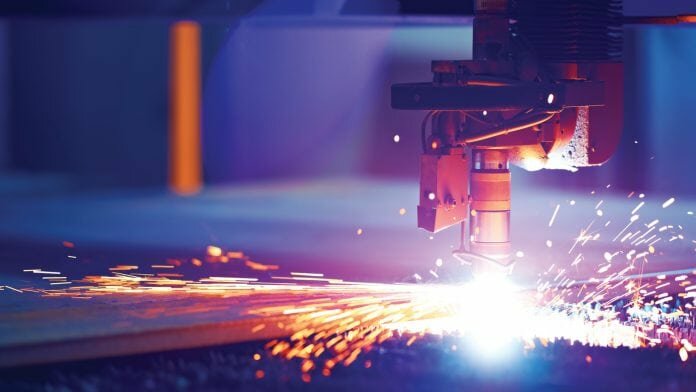
Government Europa looks at the role of lasers in manufacturing processes and how the technology is advancing industry and process.
Laser techniques are increasingly harnessed in manufacturing processes as a multi-purpose tool, particularly for the precision cutting of a variety of materials. The use of lasers in manufacturing processes means that, owing to the decreasing prominence of machining in roles in engineering jobs, economic savings are delivered through autonomy and, thus, a reduction in costs. Offering highly accurate and high-quality cutting, lasers can also provide a small kerf width and affect zone, and as a result, can easily and efficiently cut complex shapes within the metal.
Shedding light on lasers
As a column of high intensity light, wavelength or colour, laser beams vary in manifestation. The standardised CO2 laser sees the wavelength located in the infrared section of the light spectrum. As a result, it is invisible to the human eye. The beam may be bounced in various directions by mirrors before being focused onto a metal plate, at which point the laser beam travels through a nozzle before reaching its final position.
Using a specialised lens or curved mirror, the laser beam can be focused on a desired location – a process which takes place within the laser cutting head. To ensure that both the shape of the focus area and the density of energy within this area are round, consistent and centred, the beam has to be precisely focused. In focusing the laser beam to a single point, the heat density within that area is raised to extremes, subsequently resulting in a rapid increase of temperature, melting, and in some cases partial or entire vaporisation of the material.
The advantages of laser cutting
When such factors are controlled efficiently, laser cutting provides a stable, reliable and highly accurate cutting process for a variety of manufacturing processes. Offering an increased level of precision and edge quality over traditional cutting methods, laser cutting machines do not suffer from wear during the cutting process whilst enabling elaborate shapes to be cut without the need for additional tools. Moreover, laser cutting technology reduces the risk of contamination to the workpiece.
Types of laser
A computer numerical control (CNC) laser cutter uses a single beam of light to cut. It can be effective in cutting a variety of materials, including:
- Sheet metal;
- Wood;
- Diamond;
- Glass;
- Plastics; and
- Silicone.
Contemporary laser cutting has moved away from directing the beam through a lens with mirrors, and now often relies on advanced fibre optics technology to achieve the same effect. There are two dominant methods of laser cutting: laser fusion and ablative.
Melting material in a column, whilst using a high-pressure stream of gas which shears molten metal away, laser fusion cutting also leaves an open cut kerf. Meanwhile, ablative laser cutting facilitates removal of the material layer by layer, through the use of a pulse laser. As a result, the predominant result is that the material is evaporated, as opposed to being melted during cutting.
Ablative versus fusion laser cutting
There are advantages to both processes for manufacturing processes. Ablative laser cutting is typically used to make partial cuts in the desired materials, whilst laser fusion is used to cut throughout the entirety of the material. The fusion laser cutting process operates with lasers in continuous waves, or with extended pulses, leading to a molten pool which penetrates the depth of the metal. Furthermore, the molten material must be sheared via a gas stream in order to avoid the cut edges welding back together once cooled.
As reported via engineering.com, senior applications scientist at IPG Phototonics, Rouzbeh Sarrafi, said: “With sheet metal cutting – which makes up the bulk of the cutting industry – you’re mostly cutting material that is 0.5mm-12mm thick. At the current state of laser technology, laser fusion cutting is much faster for those setups. Ablative cutting takes more time, for now.”
CO2 and fibre lasers
Using an electromagnetically stimulated gas, CO2 lasers utilise a combination of carbon dioxide, nitrogen, hydrogen, and xenon or helium as active laser mediums. Meanwhile, fibre lasers – a type of solid state laser – use optical fibres, laced with elements including:
- Erbium;
- Ytterbium;
- Neodymium; and
- Dysprosium.
The laser division product manager for AMADA America, Dustin Diehl said that fibre optics are playing a growing role in laser cutting as people become more aware of their advantages: “Starting in about 2010 or 2011, fibre laser sales were about 5-10% of all laser sales. They were around before then, but they hadn’t gained much traction – people weren’t familiar with the technology.”
Erich Buholzer, product manager of laser cutting, Bystronic, added that this growth could continue unabated over the next few years: “Potentially, CO2 lasers will be replaced completely. If so, this would happen mid-term while the fibre laser technology further evolves. Currently, CO2 lasers still have some specific advantages, such as better edge quality in thick materials and smaller bursts.”
Next-generation lasers
Over the last ten years, the potential of fibre laser machines has been realised, and they now function between 10-12kW, allowing them to have a major impact on automation. Exceeding the physical capabilities of operatives and traditional methods of loading/unloading CO2 lasers, fibre laser machines offer the benefit of increased capability and speed.
Many key industry players anticipate that the future of laser efficiency will lie in automated loading/unloading for material storage, as well as in direct diode lasers, which will speed up the cutting process as well as increasing the efficiency of consumption. Direct diode lasers will eliminate the middle section of the process which those lasers undertake. The limitations of past direct diode lasers, which failed to effectively cut thicker metals due to low power levels – around 2000 watts – these lasers were of limited use to the steel cutting industry. However, recent developments have seen an increase in power, and with direct diode lasers which can now reach a capacity of 8,000 watts, their viability for use in cutting heavy materials has grown.
Direct diode lasers are set to become the next generation of lasers, owing to the benefits they could deliver, including:
- Increased efficiency;
- Higher cutting speeds; and
- A rise in cut quality.
Research has highlighted that this technology cuts around 15% faster, regardless of application, and can deliver 30% faster cut speeds in aluminium applications compared to both disc and fibre cutting. Despite this, the technology which powers direct diode lasers is still in the process of refinement and, without the automation which is so integral, speed could become irrelevant.


















